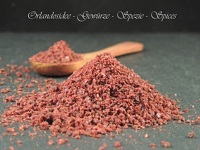
Sumac (Rhus coriaria)
Sumac is made from the dried, ground red berries of a wild-growing shrub native to the Eastern Mediterranean and West Asia. It delivers a clean, lemony tartness and a deep ruby color—an essential seasoning in Turkish, Arab and Lebanese cuisines for finishing grills, salads and dips.
- Common name: Sumac (ground berries)
- Botany: Rhus coriaria • Family: Anacardiaceae
- Form: coarse ground powder; sometimes blended lightly with salt
- Flavor: bright, citrusy, gently fruity acidity; no heat
- Use: finish at the table or bloom briefly in oil
Aroma & Flavor
Lemon-like tang with a soft berry note and subtle astringency. It brightens rich dishes without adding liquid, unlike lemon juice or vinegar.
Culinary Uses
- Grilling & roasting: dust over fish, chicken or meat after cooking; or add to dry rubs.
- Salads: classic on fattoush-style salads and tomato–cucumber mixes.
- Dips & sauces: stir into yogurt for a quick vegetable dip; finish hummus with a sprinkle and olive oil.
- Vegetables & grains: lift roasted aubergine, potatoes, lentils, bulgur, rice and couscous.
- Spice blends: a key souring note in many Levantine mixes.
How to Use
- Finish: sprinkle 1–2 pinches per portion at the end for fresh color and acidity.
- Bloom in oil: stir sumac into warm olive oil (off heat) for 20–30 s, then drizzle over dishes.
- Marinades: mix with garlic, olive oil and herbs for poultry or fish; add a final dusting after cooking to refresh the lemony note.
Dosage & Tips
- Finishing: 1/4–1/2 tsp per portion.
- Rubs/marinades: 1–2 tsp per 250 g (9 oz) protein or veg.
- Salads/dips: 1–2 tsp per bowl, adjust to taste.
- Add late: prolonged cooking mutes color and tang.
Pairings
Olive oil, garlic, onion, sesame, cumin, coriander seed, mint, parsley, thyme, paprika; great with tomatoes, cucumbers, aubergine, chicken, lamb, fish and legumes.
Ingredients & Allergens
Ingredients: Sumac berries (Rhus coriaria) — some products may include salt for balance and flow.
Allergens: none mandatory in EN labeling for this single ingredient.
Storage & Shelf Life
Keep airtight, cool, dry and away from light. Color and brightness fade with air and light; best within 12–18 months.
Substitutes & Notes
Closest effect: lemon zest plus a pinch of mild paprika (for color) or a dash of lemon juice/vinegar (adds liquid). There is no perfect 1:1 for sumac’s dry, lemony tang.
FAQ
Is sumac spicy?
No—sumac is tart and lemony without chili heat.
Can I cook sumac for a long time?
It’s best added at the end or bloomed briefly; long cooking dulls the color and acidity.
Is all sumac pure?
Some commercial sumac includes a little salt to prevent clumping and balance tartness. Check your label if you need a no-salt blend.
Merchant contact: Orlandosidee — Spice Shop (see site imprint for full company details). Email: info(at)orlandosidee.de



